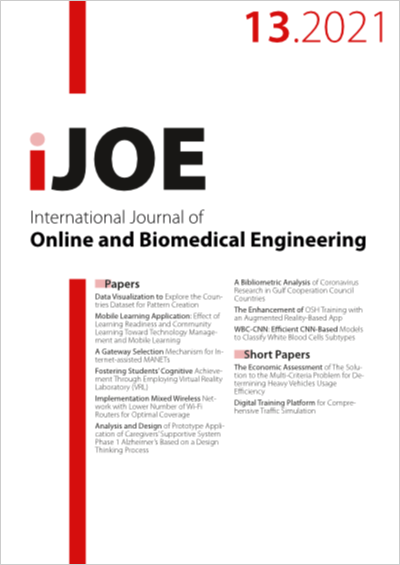Implementation Mixed Wireless Network with Lower Number of Wi-Fi Routers for Optimal Coverage
DOI:
https://doi.org/10.3991/ijoe.v17i13.24149Keywords:
Mixed Wireless Network, CR Percentage, SQR, RPR, Optimal Coverage, RSS, PLs, Delay SpreadAbstract
With the development of various wireless communication networks, Wi-Fi Router positioning and deployment systems have become widely popular in recent years to improve coverage in various environments. In this paper, we present an appropriate mechanism for defining the deployment of Wi-Fi Routers to improve coverage in the Oxford Languages Institute (OLI) environment. In addition, the institute's environment was simulated using the Wireless InSite (WI) Package. In this work, two types of Wi-Fi Routers are used. The first is the TP-Link, while the second is the Rocket. These two devices operate at 2.4 and 5 GHz frequencies. There are two objectives in this work. The first aim is to determine the best location to cover the simulated scene environment in a better way. The second aim is to compare Wi-Fi Routers to find out which Wi-Fi Router is better and find out how many Wi-Fi Routers we need to cover the institute's environment. The comparison between Wi-Fi Routers was based on basic parameters to measure the performance of wireless networks, the most important of which are Coverage Rate (CR) Percentage, Signal Quality Rate (SQR), and Received Power Rate (RPR). According to the results that were shown on the Graphical User Interface (GUI) using MATLAB Software. We noticed that the CR, SQR, and RPR of the Rocket are 83.9080%, 97.0082%, and -35.2337 dBm respectively, and these results are better than the results provided by the TP-Link, as it gave the CR, SQR, and RPR are 32.1839%, 77.8690%, and -58.1685 dBm, respectively. Finally, we conclude that CR using the Rocket is good and we need one device to cover the institute’s environment. While CR using the TP-Link is bad and we need five devices to reach the coverage provided by the Rocket because the Rocket has high transmitted power and gain capacity.
Downloads
Published
How to Cite
Issue
Section
License
Copyright (c) 2021 Karrar Shakir Muttair

This work is licensed under a Creative Commons Attribution 4.0 International License.



